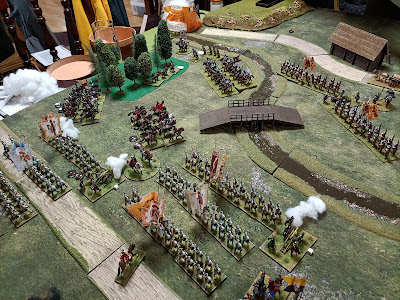Another game with rules created by Michael, the Seven Years. Michael also developed a scenario for this game, inspired by the events in Pirna in 1756. Then I made some modifications to the scenario, allowing the use of my miniatures, and we adapted it to the times of my fictional Second War of Polish Succession.
UMPIRING: Michael Schneider, Bartek Żynda
1. Forces.
2. Introduction.
After winning the battle of Psiekiszki, the combined Saxon-Polish forces reached Kraków. They waited for the arrival of the Austrian contingent, but when it didn't happen, they decided not to waste time and headed for Warsaw. On the way, they took the royal insignia from Wawel Castle. An elective Sejm was to be convened in Warsaw, where Frederick Augustus (as August IV) was to be elected king of the Polish-Lithuanian Commonwealth. The Prussian army blocked the road at the Ford over the Szreniawa River near the village of Pludraki (I made up the name of this village. It doesn't actually exist.). Despite the unfavourable weather (drizzling rain), the Polish-Saxon forces decided to cross the river. During the night, Polish peasants constructed a bridge across the river to enable some of the forces to cross to the other side. Regrettably, the Prussian commander had anticipated this and made preparations for such a situation.
3. The game.
Michael designed a challenging scenario for the game, making it much more interesting. Firstly, there was heavy rain throughout the game, so each firing unit had to check if its charge had not gotten wet. For cannons, this meant losing one charge (each cannon had 6 charges), while an infantry unit lost all ability to shoot for the entire game. The check was done with a D6 roll - 1-3 meant failure, and 4-6 meant success. Additionally, each infantry unit that crossed the river automatically lost a charge and had to undergo a drowning test, where rolling a 1 resulted in losing one level. This test also applied to cavalry. The main objective of the game was for the Polish-Saxon side to prevent the loss of the royal insignia, which were located in their camp, and to destroy as many enemy units as possible. Bonus points were awarded for transferring artillery to the other side of the river.
The battle started with Polish nobles attempting to charge across the bridge, but they were met with Prussian artillery fire and had to retreat. The retreat dampened our spirits, and we chose to take a more cautious approach.
Our initial failure emboldened the Prussians to launch more aggressive attacks. Their light cavalry crossed the river with the intention of attacking the Polish nobles, but they fell into an ambush. The Prussian forces were attacked from the flank by Polish riflemen, resulting in the destruction of a unit of Prussian hussars. Following this encounter, both sides began to act more cautiously.
The Prussians attempted to cross the river again, this time with their heavy cavalry. However, just after they crossed, they were attacked by Polish uhlans, compelling them to retreat back to their side. The high water level of the Szreniawa prevented their annihilation, as the Polish cavalry hesitated to pursue them further.
The Prussians attempted to cross the river but were met with accurate fire from Saxon cannons. Despite the large number of soaked cartridges, the Saxon cannons remained accurate, unlike the Prussian cannons, which were extremely ineffective. The Prussian infantry suffered heavy losses, and one grenadier unit was destroyed. On the other flank, the Polish riflemen drove the Prussian jaegers across the river, resulting in the end of the battle. The Prussians did not destroy the Saxon-Polish army, which were unable to cross the river and would have to find another way to reach Warsaw. The outcome was a draw, with the Saxon-Polish forces inflicted greater losses on the Prussians. The war continues, and now it is time for the Austrians to take action.
 |
| Casualties. |
4. Links.
MICHAEL:
https://meneken.blogspot.com/2024/08/polish-war-of-succession-very-wet-affair.html
SESWC:
https://www.facebook.com/Seswc.co.uk/posts/913400760817256
FLICKR:
https://www.flickr.com/photos/asienieboje/albums/72177720319976860






















Oh, jak miło zobaczyć Polaków z tego okresu w akcji!
OdpowiedzUsuńProksowani, ale zawsze obecni.
UsuńThey look like Crann Tara Miniature, very nice battle and figures.
OdpowiedzUsuńWillz.
Thanks. You are absolutely right! All my Saxons are Crann Tara.
Usuń